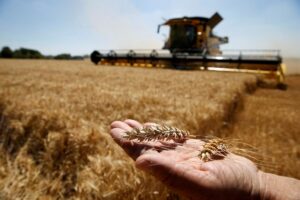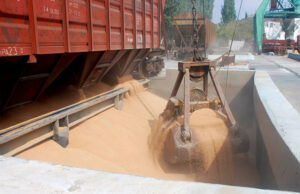
Export sales of Ukrainian wheat are steadily growing. Since the beginning of February, more than 2 million tons have been contracted, which could be a record volume of deliveries for the season. As of March, 1.4 million tons of wheat have already been sold.
This issue was discussed on February 20 during the weekly briefing organized by the analytical center of the First Agricultural Ukrainian Cooperative (FUAC), created within the Ukrainian Agri Council.
“Traders say that Indonesia is very actively involved in purchases of Ukrainian feed wheat. This Asian country has sky-high prices on the domestic market and is interested in importing grain. The demand price from Indonesia is USD260-265/t CIF. It is very profitable to export Ukrainian wheat to Indonesia. The fly in the ointment for these plans is the conflict in the Red Sea, where there is a high risk of shelling of the merchant fleet. This is still a systemic problem that negatively affects trade in the Black and Mediterranean Seas. The risk is holding back Ukrainian traders from fixing their positions in this direction. The market expects that in the second half of March, the passage of ships through the Red Sea may stop completely. A logistical solution would be to detour ships by sea through Africa, but this will raise the cost of freight by USD10-12 per ton,” was mentioned by the FUAC.
Ukrainian wheat continues to be the cheapest on most markets.
“Last week, Ukraine sold wheat with a protein content of 12.5% to Egypt at USD224 per ton for delivery to Egypt. For comparison, Russian wheat cost USD245 on an FOB basis. Ukrainian wheat is very cheap compared to other grains in the EU, Egypt and Turkey. The trade tries to keep prices low so that it makes sense to trade on many bases. Price gaps are large, which keeps the CPT market at low levels. Nevertheless, there are more and more sellers of wheat on FOB basis, many farmers are willing to sell for USD195 per ton at the Danube ports. At the same time, on CPT terms, wheat costs USD175-188 per ton, and by the end of the week, the price tags may lose another USD2 per ton,” added the analytical department of the FUAC.

Ukraine’s seaports are not yet at full capacity and are able to increase the potential of grain transportation, said Yuriy Lytvyn, Head of the Ukrainian Sea Ports Authority (USPA), at a meeting of the Grain Club of the Ukrainian Grain Association on Tuesday.
“The potential of transportation, in particular, from Odesa, is significantly higher. The proof of this is the record results of the Ukrainian “grain corridor”, which was opened after the termination of the “grain initiative” in December 2023,” he said.
According to Lytvyn, the figures for grain exports in January 2024 are slightly lower than the previous month. However, January is the month of the traditional decline in sea transportation.
At the same time, he noted an increase in the delivery of grain cargo to the ports of Greater Odesa by both rail and road.
“Today, the port of Chornomorsk has increased its car handling fivefold compared to the pre-war period. However, unfortunately, bulk cargo is not very good for Chornomorsk itself. There are some difficulties with the organization of the process,” said the USPA head.
He also emphasized that traders and local authorities are doing everything possible to speed up the process and reduce the time for unloading vehicles.
Speaking about the work of Pivdennyi port, Lytvyn noted that it is being used at 30-48% of its capacity to receive grain cargo.
“The Ministry of Infrastructure, together with the Armed Forces of Ukraine and us (USPA – IF-U), are working to expand the acceptance of cargoes that may be damaged (during the shelling of port infrastructure by the Russian side – IF-U). I mean container and ferry transportation,” Lytvyn said.
Answering a question about the fate of the port in Mykolaiv, the head of the USPA explained that the agency pays much attention to its fate and constantly consults with the military.
“The military leadership is unanimous in its position: due to security issues, unblocking the port of Mykolaiv is impossible. The ports of Mykolaiv region are under direct enemy fire from potentially dangerous areas. The military is not giving any forecasts (on the timing of their unblocking – IF-U),” he said.
The head of the USPA also reminded that Ukraine still has the occupied Kherson port, which has not yet had a single employee of the agency on its territory – it is closed.
As reported, the USPA said that Ukrainian seaports are ready to work in any case of destruction and can increase exports of agricultural goods.

In 2023, Agrotrade exported about 350 thsd tonnes of grain, of which 35%, or 116 thsd tonnes, was the share of its own products, and 65%, or 230 thsd tonnes, was from third-party producers, the company’s press service reported on Facebook.
According to the report, the agricultural holding supplied 214 thousand tons of grain to the world market by “deep water”, 108 thousand tons by the Danube, and 24 thousand tons by land.
“Despite the fact that logistics was a constant problem last year due to instability and high prices, we managed to establish ways to trade from different points – when the Black Sea ports became inaccessible, we started exporting via the Danube. And the opening of the new “grain corridor” greatly simplified our work. We were among the first in the country to use it. So far, it is working perfectly – everything is predictable and there are no queues. (…) In total, we have already shipped four ships, or 66 thousand tons of products, through the Grain Corridor 2.0,” the press service quoted Andriy But, Director of Agrotrade’s Foreign Economic Activity Department, as saying.
According to him, a significant achievement of the past year was the full sale of the agricultural holding’s own 2022 harvest and the increase in trade volumes. In particular, the company managed to export record volumes of winter rapeseed – more than 30 thsd tonnes – via the Danube in a short time. Also, in 2023, Agrotrade’s corn, soybeans and wheat were in demand on the global market.
Speaking about the plans for 2024, Booth said that the agricultural holding expects to fully export its own 2023 harvest and not slow down the pace of trade.
Agrotrade Group is a vertically integrated holding company with a full agro-industrial cycle (production, processing, storage and trade of agricultural products). It cultivates over 70 thousand hectares of land in Chernihiv, Sumy, Poltava and Kharkiv regions. Its main crops are sunflower, corn, winter wheat, soybeans and rapeseed. It has its own network of elevators with a simultaneous storage capacity of 570 thousand tons.
The group also produces hybrid seeds of corn and sunflower, barley, and winter wheat. In 2014, a seed plant with a capacity of 20 thousand tons of seeds per year was built on the basis of Kolos seed farm (Kharkiv region). In 2018, Agrotrade launched its own brand Agroseeds on the market.
Vsevolod Kozhemiako is the founder and CEO of Agrotrade.

In 2023, Ukrzaliznytsia JSC transported 30.58 million tons of grain cargo, up 5.9%, or 1.708 million tons, from a year earlier, said Valery Tkachev, deputy director of the commercial work department of UZ, at a meeting with agricultural market participants on Thursday.
According to him, 22.729 mln tons of grain crops were transported for export by rail, which is 178 thsd tonnes more than in 2022. Of these, 14.324 mln tonnes (-4.9%) were shipped to the ports, and 8 mln 405 thsd tonnes (+12.2%) – to the western border crossings.
“Before the embargo on imports of Ukrainian grain by neighboring countries was imposed in April, 900 thsd tonnes to 1 mln tonnes of grain were transported by rail per month. After the ban was imposed, the volume was almost halved. The work of ports in 2023 was significantly affected by the uncertainty of the “grain corridor”, Tkachev stated.
As reported, Ukrzaliznytsia transported 63 million tons of cargo for export in 2023.

Over 10 days in January, Ukrzaliznytsia JSC (UZ) reached an average daily load of 99.5 thousand tons, which is 37.3% more than in December, said Valery Tkachev, deputy director of UZ’s Commercial Department, at a meeting with agricultural market participants on Thursday.
“I hope that these figures will be maintained, and this will allow us to transport more than 3 million tons of grain per month,” Tkachev said.
He specified that on January 1, UZ loaded 24 thousand tons of grain, on January 2 – 63 thousand tons, but starting from January 3, this figure reached 105-123 thousand tons per day.
According to him, the share of grain cargo in the total network load is growing and has already reached 26%.
According to Mr. Tkachev, over 10 days of January, UZ transported 991.3 thousand tons of grain cargo in export traffic, including 196.9 thousand tons towards the western borders and 794.4 thousand tons towards the ports of Greater Odesa.
He noted that Chornomorsk became the leader among the ports with 257.2 thousand tons, followed by Odesa with 249.1 thousand tons and TIS in Pivdennyi with 93.4 thousand tons.
At the same time, according to Tkachev, on the western border, Yagodyn received the most grain cargo – 41.8 thousand tons of grain, followed by Vadul Siret with 36.2 thousand tons and Chop with 33.1 thousand tons.
Mr. Tkachev noted that Poland averages 85.6 railcars per day, including 51 railcars through the Yagodyn-Dorogusk crossing, 23.7 railcars through Mostyska-Medyka, and 11 railcars through Izov-Khrubeshuv.
“Over the past week, the average daily rate of railcar transfer at the Polish border increased by 10 cars per day, which is an increase of more than 13%,” Tkachev added.
According to him, Romania receives about 100 railcars with grain daily, and over the past week this figure has deteriorated by 14 w/d, or 12.3%. The Vadul-Siret crossing is followed by 66.2 v/d, Dyakove – 2.5 v/d and Reni – 31 v/d.
He clarified that Hungary averages 45.5 cars per day, and over the past week the figure has improved by 4.5 v/d, or 11%, while Slovakia – 59.3 v/d with an increase of 5.6 v/d, or 10.5% over the past week.
Tkachev emphasized that if we take oilcake and grain, the average daily transfer across all crossings is 385 v/d. Over the past week, this figure has increased by 15 vdpd, or 4%.

DTEK Group’s trading company D.Trading, which operates in the electricity, gas and coal markets, is launching grain trading, said Dmitry Malyar, CEO of the company.
“The first deal concluded on the domestic market opens a new page in the company’s history. The first thousand tons have been shipped to a customer. This is the company’s first practical step in a new trading direction,” Malyar wrote on Facebook on Tuesday.
He clarified that D.Trading’s agricultural office is already operating in Odesa.
“We will provide new market opportunities for agricultural producers and work on developing export potential,” Malyar said.